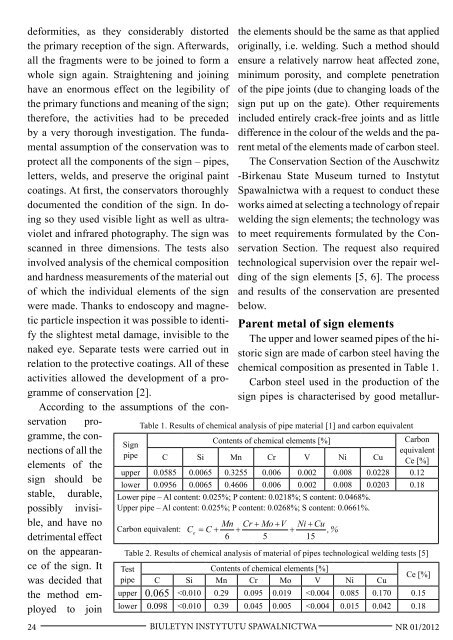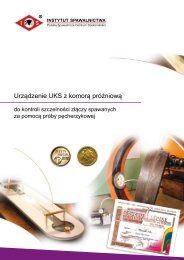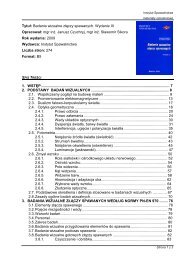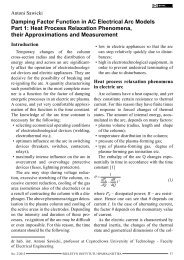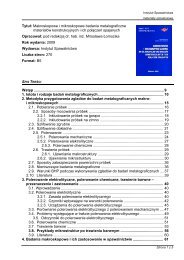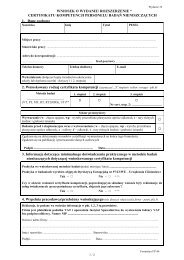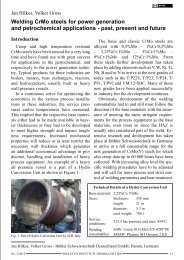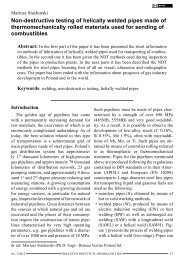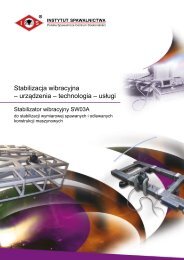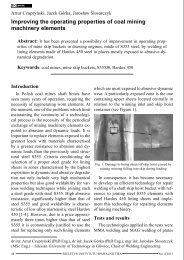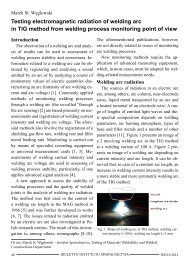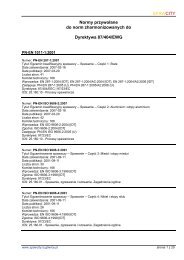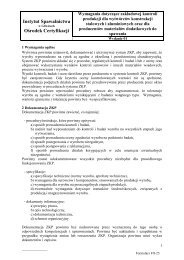Biuletyn Instytutu Spawalnictwa No. 01/2012
Biuletyn Instytutu Spawalnictwa No. 01/2012
Biuletyn Instytutu Spawalnictwa No. 01/2012
Create successful ePaper yourself
Turn your PDF publications into a flip-book with our unique Google optimized e-Paper software.
deformities, as they considerably distorted<br />
the primary reception of the sign. Afterwards,<br />
all the fragments were to be joined to form a<br />
whole sign again. Straightening and joining<br />
have an enormous effect on the legibility of<br />
the primary functions and meaning of the sign;<br />
therefore, the activities had to be preceded<br />
by a very thorough investigation. The fundamental<br />
assumption of the conservation was to<br />
protect all the components of the sign – pipes,<br />
letters, welds, and preserve the original paint<br />
coatings. At first, the conservators thoroughly<br />
documented the condition of the sign. In doing<br />
so they used visible light as well as ultraviolet<br />
and infrared photography. The sign was<br />
scanned in three dimensions. The tests also<br />
involved analysis of the chemical composition<br />
and hardness measurements of the material out<br />
of which the individual elements of the sign<br />
were made. Thanks to endoscopy and magnetic<br />
particle inspection it was possible to identify<br />
the slightest metal damage, invisible to the<br />
naked eye. Separate tests were carried out in<br />
relation to the protective coatings. All of these<br />
activities allowed the development of a programme<br />
of conservation [2].<br />
According to the assumptions of the conservation<br />
programme,<br />
the connections<br />
of all the<br />
elements of the<br />
sign should be<br />
stable, durable,<br />
possibly invisible,<br />
and have no<br />
detrimental effect<br />
on the appearance<br />
of the sign. It<br />
was decided that<br />
the method employed<br />
to join<br />
Sign<br />
pipe<br />
24 BIULETYN INSTYTUTU SPAWALNICTWA<br />
the elements should be the same as that applied<br />
originally, i.e. welding. Such a method should<br />
ensure a relatively narrow heat affected zone,<br />
minimum porosity, and complete penetration<br />
of the pipe joints (due to changing loads of the<br />
sign put up on the gate). Other requirements<br />
included entirely crack-free joints and as little<br />
difference in the colour of the welds and the parent<br />
metal of the elements made of carbon steel.<br />
The Conservation Section of the Auschwitz<br />
-Birkenau State Museum turned to Instytut<br />
<strong>Spawalnictwa</strong> with a request to conduct these<br />
works aimed at selecting a technology of repair<br />
welding the sign elements; the technology was<br />
to meet requirements formulated by the Conservation<br />
Section. The request also required<br />
technological supervision over the repair welding<br />
of the sign elements [5, 6]. The process<br />
and results of the conservation are presented<br />
below.<br />
Parent metal of sign elements<br />
The upper and lower seamed pipes of the historic<br />
sign are made of carbon steel having the<br />
chemical composition as presented in Table 1.<br />
Carbon steel used in the production of the<br />
sign pipes is characterised by good metallur-<br />
Table 1. Results of chemical analysis of pipe material [1] and carbon equivalent<br />
Contents of chemical elements [%]<br />
C Si Mn Cr V Ni Cu<br />
Carbon<br />
equivalent<br />
Ce [%]<br />
upper 0.0585 0.0065 0.3255 0.006 0.002 0.008 0.0228 0.12<br />
lower 0.0956 0.0065 0.4606 0.006 0.002 0.008 0.0203 0.18<br />
Lower pipe – Al content: 0.025%; P content: 0.0218%; S content: 0.0468%.<br />
Upper pipe – Al content: 0.025%; P content: 0.0268%; S content: 0.0661%.<br />
Carbon equivalent: C Mn Cr + Mo + V Ni + Cu<br />
= C + +<br />
+ ,%<br />
6 5 15<br />
Table 2. Results of chemical analysis of material of pipes technological welding tests [5]<br />
Test<br />
Contents of chemical elements [%]<br />
pipe C Si Mn Cr Mo V Ni Cu<br />
Ce [%]<br />
upper 0.065


